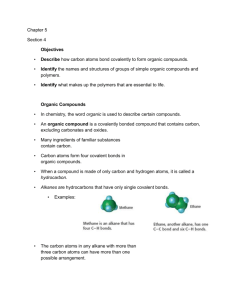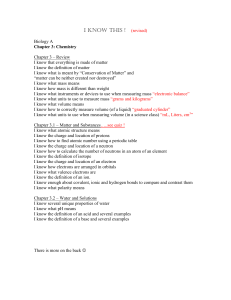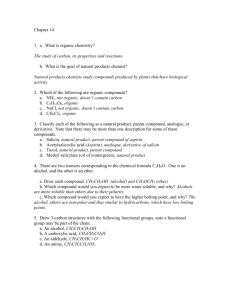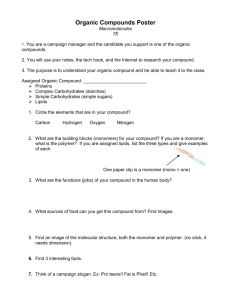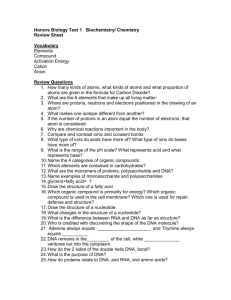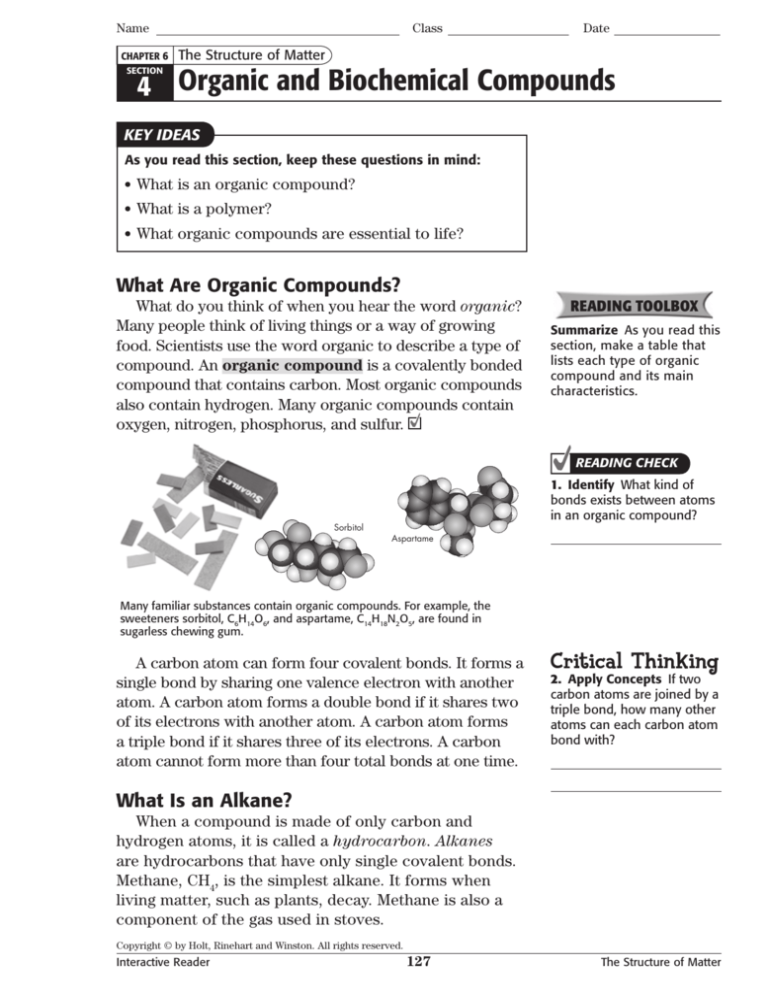
Name
CHAPTER 6
Class
Date
The Structure of Matter
SECTION
4 Organic and Biochemical Compounds
KEY IDEAS
As you read this section, keep these questions in mind:
• What is an organic compound?
• What is a polymer?
• What organic compounds are essential to life?
What Are Organic Compounds?
What do you think of when you hear the word organic?
Many people think of living things or a way of growing
food. Scientists use the word organic to describe a type of
compound. An organic compound is a covalently bonded
compound that contains carbon. Most organic compounds
also contain hydrogen. Many organic compounds contain
oxygen, nitrogen, phosphorus, and sulfur.
READING TOOLBOX
Summarize As you read this
section, make a table that
lists each type of organic
compound and its main
characteristics.
READING CHECK
1. Identify What kind of
bonds exists between atoms
in an organic compound?
3ORBITOL
!SPARTAME
Many familiar substances contain organic compounds. For example, the
sweeteners sorbitol, C6H14O6, and aspartame, C14H18N2O5, are found in
sugarless chewing gum.
A carbon atom can form four covalent bonds. It forms a
single bond by sharing one valence electron with another
atom. A carbon atom forms a double bond if it shares two
of its electrons with another atom. A carbon atom forms
a triple bond if it shares three of its electrons. A carbon
atom cannot form more than four total bonds at one time.
8g^i^XVa I]^c`^c\
2. Apply Concepts If two
carbon atoms are joined by a
triple bond, how many other
atoms can each carbon atom
bond with?
What Is an Alkane?
When a compound is made of only carbon and
hydrogen atoms, it is called a hydrocarbon. Alkanes
are hydrocarbons that have only single covalent bonds.
Methane, CH4, is the simplest alkane. It forms when
living matter, such as plants, decay. Methane is also a
component of the gas used in stoves.
Copyright © by Holt, Rinehart and Winston. All rights reserved.
Interactive Reader
127
The Structure of Matter
Name
SECTION 4
Class
Date
Organic and Biochemical Compounds continued
-ETHANE
%THANE
Methane and ethane are the two simplest hydrocarbons.
READING CHECK
3. Define What is a normal
alkane?
Math Skills
4. Calculate If a normal
alkane contains 15 carbon
atoms, how many hydrogen
atoms does it contain?
Methane has only C—H single bonds. However, all
other alkanes have one or more C—C single bonds.
Molecular models of methane and ethane, C2H6, are
shown above.
The carbon atoms in methane, ethane, and propane are
all bonded in a single line. There are no other arrangements
possible for these three hydrocarbons. When an alkane’s
carbon atoms are bonded in a straight line, it is called a
normal alkane (n-alkane). Several normal alkanes are
shown in the table below.
n-Alkane
Molecular formula
Condensed structural formula
Methane
CH4
CH4
Ethane
C2H6
CH3CH3
Propane
C3H8
CH3CH2CH3
Butane
C4H10
CH3(CH2)2CH3
Pentane
C5H12
CH3(CH2)3CH3
Hexane
C6H14
CH3(CH2)4CH3
Heptane
C7H16
CH3(CH2)5CH3
Octane
C8H18
CH3(CH2)6CH3
Nonane
C9H20
CH3(CH2)7CH3
Decane
C10H22
CH3(CH2)8CH3
Carbon atoms in an alkane that has more than
three carbon atoms can have more than one possible
arrangement. Carbon atom chains may have branches
or form rings. The figure on the next page shows
several ways that six carbon atoms can be arranged.
Except for cyclic alkanes, or alkanes that form rings,
the chemical formula for alkanes follows a special pattern:
CnH2n + 2
Some alkanes may share a chemical formula. For
example, all of the six-carbon alkanes on the next page,
except cyclohexane, have the chemical formula C6H14, or
(C6H2(6) 2).
Copyright © by Holt, Rinehart and Winston. All rights reserved.
Interactive Reader
128
The Structure of Matter
Name
Class
SECTION 4
Date
Organic and Biochemical Compounds continued
Some Six-Carbon Alkanes
(
(#(
H H H H H H
H
C
H
C
C
C
C
C
H
H H H H H
Hexane
( (#( (
(
( #
#
# # (
(
(
(
(
.FUIZMQFOUBOF
(
(
( (#( (#( (
( #
(
#
#
(
(
%JNFUIZMCVUBOF
(
#
# (
(
(
( (
(
#
(
#
#
( (
(
#
#
(
(
EHHDBG@<EHL>K
5. Compare All of these
alkanes, except cyclohexane,
have the same chemical
formula. Why, then, are these
three different compounds?
6. Identify What is the
chemical formula for
cyclohexane?
(
$ZDMPIFYBOF
What Are Alkenes?
Alkenes are hydrocarbons with a double bond between
at least two carbon atoms. A double bond is represented
by two lines between the two carbon atoms, CC.
Alkenes are named by replacing the -ane ending used for
alkanes with -ene.
The simplest alkene is ethene (also called ethylene),
C2H4. Ethene forms when fruit ripens. Propene
(propylene), C3H6, is used in some plastics.
8g^i^XVa I]^c`^c\
7. Infer Can an alkene
contain single bonds
between carbon atoms?
Explain your answer.
%PVCMF
CPOE
%PVCMF
CPOE
Ethene
Propene
The peaches in the plastic bowl release ethene gas as they ripen. The
plastic that forms the bowl was made by joining propene molecules.
Copyright © by Holt, Rinehart and Winston. All rights reserved.
Interactive Reader
129
The Structure of Matter
Name
SECTION 4
Class
Date
Organic and Biochemical Compounds continued
8g^i^XVaI]^c`^c\
8. Compare How does the
structure of methanol differ
from the structure of
methane?
READING CHECK
9. Explain Why do alcohols
have higher boiling points
than alkanes of similar sizes
do?
What Are Alcohols?
Alcohols are organic compounds that contain a
hydroxyl, –OH, group. Methanol, CH3OH, and ethanol,
CH3CH2OH, are the simplest alcohols. Notice that the
names of these alcohols ends in -ol. The names of most
alcohols end in -ol.
Like water molecules, alcohol molecules attract one
another due to hydrogen bonding. Hydrogen bonds form
between the oxygen atom of one alcohol molecule and
the hydrogen atom of another molecule. Because of
these attractions, alcohols are generally liquids at room
temperature. Alcohols have higher boiling points than
alkanes of a similar size do.
What Are Polymers?
A polymer is a large molecule made of a chain of
smaller, repeating molecules. Many natural products
are made up of polymers. Rubber, wood, cotton, wool,
starch, protein, and DNA are all natural polymers.
Human-made polymers are usually plastics, such as
the milk jug shown in the figure below, or fibers, such as
nylon. Most plastics are flexible and easily molded, and
fibers form long, thin strands.
Polypropene (polypropylene) can be used to make both
plastics and fibers. Polypropene is molded to make plastic
containers, some car parts, and appliances. It is also used
to make carpets and artificial turf for athletic fields.
%THENEUNIT
This plastic milk jug is made of polyethene. Polyethene is a polymer
made of repeating units of ethene.
Copyright © by Holt, Rinehart and Winston. All rights reserved.
Interactive Reader
130
The Structure of Matter
Name
SECTION 4
Class
Date
Organic and Biochemical Compounds continued
MONOMERS
The name polyethene (also called polyethylene or
polythene) tells you the basic structure of the polymer.
Ethene is an alkene that has the chemical formula C2H4.
Poly means “many.” Thus, polyethene means “many ethenes.”
Polyethene is a polymer made up of monomers of
ethene. A monomer is a repeating unit that makes up a
polymer.
8g^i^XVa I]^c`^c\
10. Infer What does the
name polystyrene tell you
about the structure of the
compound?
POLYMER PROPERTIES
The way polymer chains join together to form
substances determines the properties of the substance.
The arrangement of polymer chains in some substances makes the substance flexible. For example,
you can crush or dent a milk jug because the plastic is
flexible. However, the plastic is not elastic, so it will
not return to its original shape.
The arrangement of polymer chains in other
substances makes the polymer elastic. For example,
rubber bands are made up of elastic polymers. As long
as you do not stretch a rubber band too far, it can
return to its original shape.
What Are Biochemical Compounds?
Biochemical compounds are organic compounds that
can be made by living things. Biochemicals are essential
to life. They include carbohydrates, proteins, and DNA.
Each of these biochemicals is a polymer.
READING CHECK
11. List What are three
biochemical polymers?
Carbohydrates give athletes plenty of quick energy. The athletes also need
plenty of protein in their diets to help build up their muscles.
Copyright © by Holt, Rinehart and Winston. All rights reserved.
Interactive Reader
131
The Structure of Matter
Name
SECTION 4
Class
Date
Organic and Biochemical Compounds continued
CARBOHYDRATES
READING CHECK
12. List What three
elements make up a
carbohydrate?
Carbohydrates are biochemical compounds made up
of carbon, hydrogen, and oxygen. Some carbohydrates,
such as sugars, are small molecules. However, many
carbohydrates are large molecules made of chains of
sugars. For example, starch is made of glucose monomers.
Potatoes and pasta are some foods that contain starch.
When you eat starchy foods, enzymes in your body
break down the carbohydrate polymers into their
monomers. Your body uses enzymes to break down starches
so that your cells can use the molecules of glucose.
Your cells use glucose for energy. However, your body
can store extra glucose as glycogen. Glycogen is another
polymer made up of glucose molecules. When you need
energy later, your body breaks down glycogen into
glucose monomers that your cells can use.
PROTEINS
READING CHECK
13. Identify What monomers make up proteins?
Proteins are organic compounds made of chains of
amino acids. Amino acids are smaller molecules made
of carbon, hydrogen, oxygen, and nitrogen. Some amino
acids contain sulfur. Each protein is made of a specific
combination and number of amino acids. The sequence
of amino acids in a protein determines the protein’s
structure and function.
Foods that contain proteins include cheeses and
meats. When you eat foods that contain protein, your
body breaks down the protein into individual amino
acids. Your cells use the amino acids to make other proteins that your body needs.
4
4
4
4
4
4
Proteins are made up of monomers called amino acids. Each ball in the
chain represents an amino acid. Different chains may be linked together
by sulfur ions. These links are called disulfide bridges.
Copyright © by Holt, Rinehart and Winston. All rights reserved.
Interactive Reader
132
The Structure of Matter
Name
SECTION 4
Class
Date
Organic and Biochemical Compounds continued
DNA
All of your genes are made of DNA molecules.
DNA is a long molecule made of carbon, hydrogen,
oxygen, nitrogen, and phosphorus. DNA is made up of
monomers called nucleotides. Each nucleotide has one of
four bases: adenine, thymine, guanine, and cytosine.
The figure below shows the complex structure of
DNA. The shape of a DNA molecule is a double helix.
A double helix looks like a twisted ladder.
Two chains of nucleotides form the strands of DNA.
The strands are held together by attractions between
bases on opposite strands.
!
#
READING CHECK
14. Identify What monomers make up DNA?
4
'
3UGAR
MOLECULE
0HOSPHATE
UNIT
In DNA, cytosine, C, always pairs with guanine, G. Adenine, A,
always pairs with thymine, T.
DNA carries the instructions for making proteins. Each
group of three bases along a strand of DNA represents a
specific amino acid. The sequence of bases in DNA
determines the sequence of amino acids in proteins.
Almost every cell in your body contains a copy of your
DNA. When a cell divides, DNA strands separate and a
copy is made from the old strands.
READING CHECK
15. Identify Relationships
How is the sequence of
bases in DNA related to the
sequence of amino acids in
proteins?
Copyright © by Holt, Rinehart and Winston. All rights reserved.
Interactive Reader
133
The Structure of Matter
Name
Class
Date
Section 4 Review
Section Vocabulary
amino acid a compound of a class of simple
organic compounds that contain a carboxyl
group and an amino group and that combine
to form proteins
carbohydrate a class of molecules that includes
sugars, starches, and fiber; contains carbon,
hydrogen, and oxygen
organic compound a covalently bonded
compound that contains carbon, excluding
carbonates and oxides
polymer a large molecule that is formed by
more than five monomers, or small units
protein an organic compound that is made of
one or more chains of amino acids and that is
a principal component of all cells
1.Apply Concepts A particular alkane and a particular alkene have the same num-
ber of carbon atoms joined in a chain. Which compound contains more hydrogen
atoms? Explain your answer.
2.Identify Complete the table below to identify each compound as an alkane, an
alkene, or an alcohol based on its name.
Compound
Alkane, alkene, or alcohol?
2-methylpentane
3-methyloctane
1-nonene
2-butanol
3-heptene
cyclohexanol
3.Identify Which of the following compounds is an alkane: CH2O, C6H14, or C3H4?
Explain your answer.
4.Analyze Patterns Alkynes are hydrocarbons that have triple bonds between at
least two carbons. What is the name of the compound that has the chemical formula C3H4?
5.Identify Relationships What is the relationship between monomers and polymers?
Copyright © by Holt, Rinehart and Winston. All rights reserved.
Interactive Reader
127-134_SP_C06_STR_S04.indd 134
134
The Structure of Matter
4/5/07 1:01:09 PM

